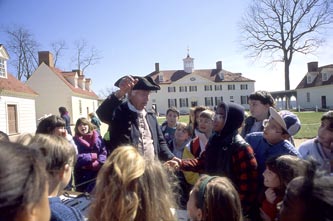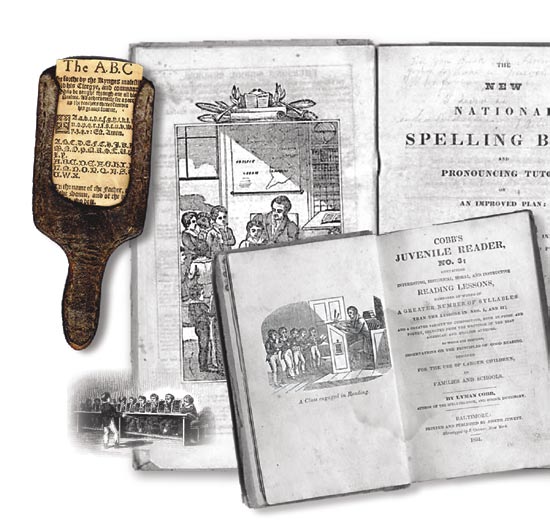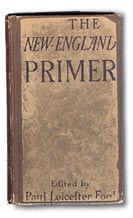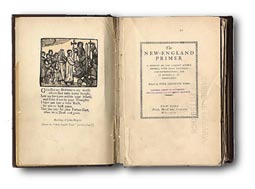be made complete by “so prudent a use of this
of a democratic republic, one might mention an incident
blessing.”
from his earlier years. He had ended his military career
as the revolutionary commander with a poignant fare-
Finally, desiring “the permanency” of “your happiness
well to the officers who had served faithfully under him.
as a people,” he offered disinterested advice similar to
Woodrow Wilson noted that, in the final years of the
that he urged when he disbanded the army.
Revolutionary War and “the absence of any real govern-
On that occasion, Washington, drafting his 1783 “Circu-
ment, Washington proved almost the only prop of author-
lar Address,” was responding to the urgings of several of
ity and law.” How this arose from Washington’s character
his colleagues to leave his countrymen a political testa-
was displayed fully in Fraunces Tavern, November 23,
ment to guide their future considerations. Washington
1783. The British had departed New York, and the
acknowledged these urgings
general bade farewell to
in a letter to Robert Morris
his men. At that emotional
on June 3, 1783, by stating
moment, at a loss for words,
that he would “with greatest
according to contemporary
freedom give my sentiments
accounts, Washington raised
to the States on several polit-
his glass: “With heart full
ical subjects.” He followed
of love and gratitude, I now
the same model in 1796,
take my leave of you.” He
upon leaving the presidency,
extended his hand, to shake
without need of urging.
the hands of his officers
Washington’s retirement
filing past. Henry Knox
from the presidency in 1796
stood nearest and, when
after two four-year terms
the moment came to shake
in office was important
hands and pass, Washington
because it cemented the
impulsively embraced and
concept of a limited presi-
kissed that faithful general.
dency. Washington could
Then, in perfect silence,
Washington’s retirement was made gratifying by his love for his plantation, have used his military stature
he so embraced each of his
Mount Vernon.
and his enormous popular-
officers as they filed by, and
ity to become an autocrat; yet, he refused to do so. His
then they parted. This dramatic end to eight years of
modesty certainly appealed to the public. The spon-
bloody travail demonstrates Washington’s instinctive
taneous and universal acclaim that welcomed him home
wish to build concord out of conflict, and his ability to
from the Revolutionary War in 1783 was duplicated on
recognize the merit and value of others, as well as his
this occasion.
own.
This time, however, he had completed a much more
When Washington declared, upon retiring from the
trying task, the increasingly bitter party strife having
presidency decades later, that “`Tis substantially true,
made even him an open target. Not only had the coun-
that virtue or morality is a necessary spring of popular
try been solidified and its finances put in order, but also
government,” he stated in words what his earlier actions
ominous threats of foreign war that loomed over his last
symbolized: that the success of the democratic enterprise
five years in office had greatly declined even while the
depends on a certain willingness to give others their due
country had been strengthened. Washington also took
and to relinquish some claims of the ego and of power.
satisfaction that resignation removed him from that
The very first condition for the preservation of a demo-
unfamiliar position of being held up to public scorn and
cratic republic, Washington believed, is the foundation
ridicule by “infamous scribblers,” a source of grief and
within the individual of prudent reason. Speaking of
irritation to every president since Washington as well.
the people as a whole, Washington ultimately called this
quality “enlightened opinion” and “national morality.”
20


By commending morality and reason to the American
amendment) represents continuing affirmation of the
people as he left office, Washington hoped that the
people’s authority.
power of his example had made them capable of follow-
ing duty over inclination. By limiting his own behav-
W. B. Allen is a professor of political science at Michigan State University, ior and prerogatives in office and by enduring conflict
specializing in political philosophy, American government, and jurisprudence.
Currently on sabbatical leave, he is a visiting fellow in the James Madison without resorting to tyranny, Washington made it clear
Program, Department of Politics, Princeton University,
that he wished his legacy to be a true democracy, and not
translating Montesquieu’s Spirit of the Laws . His publications include a reversion to traditional autocracy. His refusal to seek
George Washington: A Collection , and Habits of Mind:
a third presidential term cemented that. Washington’s
Fostering Access and Excellence in Higher Education
“falling” in 1796 was his people’s rising. Continuing
(with Carol M. Allen).
respect for the two-term presidential precedent in the
United States (now enforced by constitutional
Tourists can visit Mount Vernon today, to get a
glimpse of Washington’s America.
21


The technology of education has changed, at least to some extent,
since the time of the 16th-century hornbook shown at left, or of 19th-century schoolbooks (below). Over the course of history, however, what information children should be taught, what methods should be used, and who may have access to education, have been perennial social issues.
22











by Carl F. Kaestle
Victory of the Common School Movement:
A Turning Point in
American Educational History
AMERICANS TODAY COUNT ON THEIR PUBLIC SCHOOLS
TO BE FREE OF EXPENSE, OPEN TO ALL, AND DEVOID OF
RELIGIOUS SECTARIANISM. ALTHOUGH FAMILIES ARE
PERMITTED TO ENROLL THEIR CHILDREN IN PRIVATE
SCHOOLS AT THEIR OWN EXPENSE IN THE UNITED STATES,
THE PERCENTAGE OF PRIVATE SCHOOL STUDENTS HAS
BEEN STABLE AT ABOUT 10 - 12 PERCENT FOR HALF A
CENTURY. THE GREAT MAJORITY OF STUDENTS ATTEND
PUBLIC SCHOOLS, FROM THE FIRST TO THE TWELFTH YEAR
OF SCHOOLING, THE FULFILLMENT OF A CRUCIAL POLICY
DECISION MADE IN EACH INDIVIDUAL STATE IN THE NORTH-
ERN PART OF THE COUNTRY IN THE 1840S, AND IN THE
SOUTHERN STATES IN THE LATE NINETEENTH CENTURY.
IT WAS CALLED “THE COMMON SCHOOL MOVEMENT.”
Horace Mann, pictured here, an educational reformer of the 1840s.
23

Free schools open to all children did not exist in colo- taught children their ABC’s through rhymed couplets, nial America. Yet, something like modern American
beginning with “In Adam’s Fall, We sinned all,” and
public schools developed in the 1840s, when a majority
concluding with “Zaccheus he Did climb the Tree, Our
of voters in the northern regions of the United States
Lord to see.”
decided that it would be wise to create state-mandated
Schools offered brief terms, perhaps six weeks in win-
and locally controlled free schools. Once this model of
ter and another six weeks in summer, attended mainly
schooling prevailed, the stage was set for the creation of
by young children who were not working in the fields.
an inclusive free-school system in the United States.
These practices swayed to the rhythms of agricultural
In the British colonies of the 17th and 18th centuries,
work and the determination of most towns to provide
schooling was not compulsory, not free of charge, not
only modest resources for schools. Formal schooling was
secular, not open to all, and not even central to most
more extensive for a tiny elite, as it was in America’s par-
children’s education. Decisions about the provision
ent country, England. In the colonies, only a few boys of
of schools were made town-by-town. Girls were often
European ancestry might go on to more advanced schools
excluded, or allowed to attend only the lower-level
for English grammar and then, for an even smaller
schools, and sometimes at different hours from the boys.
number, tutoring in Latin, leading to Harvard College, or
In most towns, parents had to pay part of the tuition to
Yale, or William and Mary. The majority of these privi-
get their young educated. These barriers to the educa-
leged few then became ministers, rather than leaders in
tion of all characterized the New England colonies in
secular society.
the Northeast as well as those in the middle-Atlantic and
The rest of the children learned most of their literacy,
the South. In those sections of North America that were
adult roles, work skills, and traditions outside of school,
then governed by Spain or France, even less was done
from a constellation of institutions, principally the home,
for education. Christian missionaries made intermit-
the workplace, and the church. However, as colonial
tent efforts to evangelize Native Americans and African
society became more highly populated, more complex,
Americans through religious education across North
and more riven by faction in the 18th century, competi-
America; but schooling, whether local or continental, was
tion among rival Protestant denominations and quarrels
not primarily a governmental matter.
developed over religious doctrine. In addition, political
and financial issues ultimately brought relations between
The Religious Roots of Colonial the colonists and the English homeland to a breaking point. Thus, the uses of literacy for argumentation
Schooling
– both in oral and written form – grew. And as agricul-
ture became more commercial and efficient, it brought
more cash transactions, more focus on single crops, and
However, in spite of patchwork, casual customs of
the prospect of more distant markets, into the country-
schooling throughout the British colonies, there was a
side, reinforcing the value of literacy. In the growing
push for literacy among many colonists, based largely
coastal towns of Boston, New York, Philadelphia, and
on the Protestant belief that lay people should learn
Charleston, and in some inland centers like Albany and
to read the Bible in the vernacular tongue (that is, for
Hartford, philanthropic groups and churches, responding
British colonists, in English, rather than Latin or Greek).
to the increase in poverty and its visibility, established
Passing a law in 1647 for the provision of schools, the
free schools for the moral education of poor children, on
Massachusetts colonial legislature commented that “old
the model of English “charity” schools.
deluder Satan” had kept the Bible from the people in
the times before the Protestant Reformation, but now
they should learn to read. Thus, the legislature decreed,
towns of over 50 families should provide a school. They
did not specify that the education had to be free, nor did
they require attendance. The law was weakly enforced.
In effect, parents decided whether to send their children;
if they did, they had to pay part or all of the cost; and
religion was without doubt or question intertwined with
education in those days. The most popular schoolbook
in British colonial America, The New England Primer,
24


The Common School Movement ing in these institutions. Even for white children, the terms were brief, the teachers often poorly educated,
and the buildings generally in poor condition. The rural
Given these 18th-century dynamics, one might have school became a favorite target of school reformers later expected that when the colonists’ victory over
in the early 19th century. Michigan’s superintendent,
British forces in the American Revolution finally left
John Pierce, called little rural districts “the paradise of
newly-minted Americans free to establish republican
ignorant teachers”; another report spoke of a district
institutions to their liking, schools would have been high
school building in such bad repair that “even the mice
on the list. Indeed, many of the Revolution’s leaders
had deserted it.”
thought they should be – including Thomas Jefferson
and Benjamin Rush. Jefferson wrote from France in
1786, advising a friend to “preach a crusade against
The Monitorial School Model
ignorance,” and support free schools in Virginia. Rush, a
Philadelphia physician and signer of the Declaration of
In cities, there were more opportunities. Even in the
Independence, proposed a similar bill for free schools in
18th century in urban areas, there were several differ-
Pennsylvania.
ent kinds of schools, funded in different
Leaders of this movement for state
ways and with different levels of financial
systems of common schools in the early
resources. A modest amount of “charity”
national period came from both the Jef-
schooling provided some free instruction
fersonian Republicans and the Federal-
for children of poor whites and of African
ists. But their efforts failed in their state
Americans, often subsidized by churches
legislatures. Most free citizens, it appears,
and by state and local government. Such
thought that the patchwork colonial mode
efforts resulted in African Free Schools,
of education was still quite sufficient. In
“infant” schools for the two- and three-
particular, Americans were wary of any
year-old children of the indigent, and
increase in taxes (which had been a major
other types of sponsorship. As time
point of contention with England) and did
passed and as concern grew, many cities
not want their fledgling state governments
in the new Republic experimented with
to meddle in affairs that had always been
a type of charity school, the “monitorial”
local matters for towns or families to de-
school, which became popular in Eng-
cide. After Jefferson’s bill for free schools
land, Europe, and Latin America in the
in the Virginia legislature had failed twice,
1810s and ‘20s. Invented by Joseph Lan-
he complained to his friend Joel Barlow in
caster, a Quaker schoolmaster in England,
1807, “There is a snail-paced gait for the
the “monitorial” school model encour-
advance of new ideas on the general mind, This schoolbook was published in 1727 in aged more advanced pupils to teach those under which we must acquiesce.” Boston and later reprinted. “Primer” who were less advanced. Lancaster wrote originally meant book of prayers; it came
Thus, in the countryside, towns still
to mean an introductory school text. The many manuals in his efforts to popularize decided whether to have a school, and
boundary between religious and secular edu- the methods. Lancaster attempted to de-if so, how to fund it. The cost was usu-
cation is still being defined in many societies. fine appropriate discipline and to provide ally covered through some combination of taxes on all
detailed instructions for classroom procedures. At a time
citizens plus tuition fees for the parents of children who
when boys were routinely paddled for school infractions,
attended. Sometimes parents paid by providing food
advocates applauded Lancaster’s ideas about motivation
for the teacher or firewood for the school, but usually
without corporal punishment, discipline motivated by an
it was cash. Parental payments were called “rate bills.”
active curriculum and competition, neutrality with regard
Sometimes the school would be free for all children for
to religious denominations, and, perhaps most important,
a set amount of time and then a “continuation” school
economy of expense. Lancaster claimed that with his
would be provided for those whose parents were able
system a single master could teach 500 poor children at
to pay. Thus the amount of schooling a child received
a time. By the 1820s, Lancasterian schools had popped
was in the last analysis determined by wealth. At most,
up in Pittsburgh, Harrisburg, and many other Pennsyl-
there would be a single school for each town or district.
vania towns; in Detroit, Michigan; Washington, D.C.;
Blacks and Indians in general received no formal school-
Hartford and New Haven, Connecticut; Norfolk and
25


Richmond, Virginia; and dozens of other cities. In New
munity. Traditional opponents of taxation labelled this
York City and in Philadelphia, reformers organized entire
an unwarranted and oppressive intrusion of state govern-
networks of Lancasterian monitorial schools, systems that
ment into local affairs; however, Henry Barnard, Con-
became the physical and organizational basis of the later
necticut’s school superintendent, called it “the cardinal
public free schools of those cities. Later critics derided
idea of the free school system.” Reformers also urged
the monitorial schools for regimenting their poor students
the centralization of the little rural districts into larger
and separating them from other children, but Lancaster’s
town-wide units, for better supervision and support.
ideas helped popularize the notion of a school “system,”
Simultaneously, in urban settings, school reformers of the
referring not only to the pedagogy and curriculum but to
same period began to focus their efforts on absorbing the
the organization of schools into a network.
charity schools into free public school systems and then
For parents with a bit more money, there were inex-
trying to attract the children of more affluent parents into
pensive pay schools advertised in the newspapers, taking
these “common” schools. The idea of the school as a
in children whose parents could afford a few shillings
common, equal meeting ground took on great force for
a quarter. The wealthy educated their children with
reformers, and they aimed their criticisms at the evils of
private tutors or sent them to expensive boarding schools
private schools. A system of private schools for the rich,
in the English style, now
said Orville Taylor in 1837,
increasingly available to the
“is not republican. This
English-speaking ex-colo-
is not allowing all, as far as
nials. The cream of soci-
possible, a fair start.” The
ety might even send their
present system, Henry
favored sons and daughters
Barnard complained, “clas-
to acquire intellectual and
sifies society . . . assorting
social finesse in academies
children according to
abroad. Well into the 1820s
the wealth, education, or
and ‘30s, “free” education
outward circumstances of
thus connoted only limited
their parents.” As Jeffer-
privileges granted to the
son had discovered earlier,
poor, and was distinctly
however, old practices
dependent on the goodwill
die hard. Even Horace
of local congregations, both
Mann, the best known of
Protestant and Catholic,
the education reformers in
or perhaps the largesse of
the 1840s, lamented the
Modern tastes might find this old primer rather gloomy and limiting. Most would nondenominational philan-argue that pedagogy has improved over the centuries.
slow progress of his efforts,
thropic societies. In New
labeling his opponents as
York and elsewhere these charity schools might receive
“an extensive conspiracy” of “political madmen.”
some support, variously from the city council or the state.
There remained much support for small-scale district
Our current distinction between “private” and “public”
control. In Massachusetts, for example, traditional Prot-
education had not yet crystallized.
estants of the Congregational denomination rightly per-
ceived that the state would use its influence to discour-
The Common School Reform
age the advocacy of particular doctrines in such common
schools. In New York state, a petition from a little town
Movement Gathers Steam
in Onondaga County complained that the newly passed
school law of 1849 allowed people “to put their hands
into their neighbors’ pockets” to get support for schools.
Meanwhile, in the small towns and countryside,
Roman Catholics in New York City fought the creation























